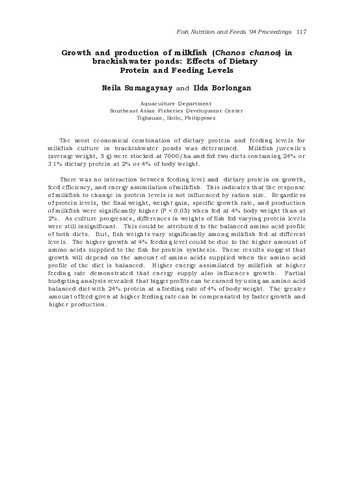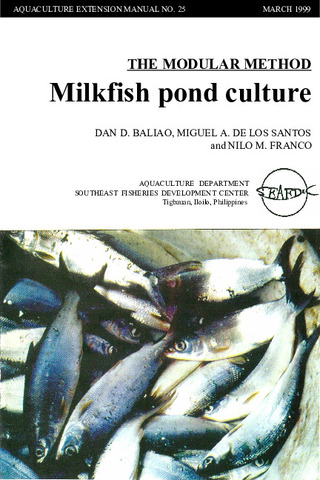Growth and production of milkfish (Chanos chanos) in brackishwater ponds: effects of dietary protein and feeding levels
| dc.contributor.author | Sumagaysay, Neila | |
| dc.contributor.author | Borlongan, Ilda | |
| dc.date.accessioned | 2011-07-18T14:19:05Z | |
| dc.date.available | 2011-07-18T14:19:05Z | |
| dc.date.issued | 1996 | |
| dc.identifier.uri | http://hdl.handle.net/10862/549 | |
| dc.description | Abstract only | en |
| dc.description.abstract | The most economical combination of dietary protein and feeding levels for milkfish culture in brackishwater ponds was determined. Milkfish juveniles (average weight, 5 g) were stocked at 7000/ha and fed two diets containing 24% or 31% dietary protein at 2% or 4% of body weight.There was no interaction between feeding level and dietary protein on growth, feed efficiency, and energy assimilation of milkfish. This indicates that the response of milkfish to change in protein levels is not influenced by ration size. Regardless of protein levels, the final weight, weight gain, specific growth rate, and production of milkfish were significantly higher (P < 0.05) when fed at 4% body weight than at 2%. As culture progresses, differences in weights of fish fed varying protein levels were still insignificant. This could be attributed to the balanced amino acid profile of both diets. But, fish weights vary significantly among milkfish fed at different levels. The higher growth at 4% feeding level could be due to the higher amount of amino acids supplied to the fish for protein synthesis. These results suggest that growth will depend on the amount of amino acids supplied when the amino acid profile of the diet is balanced. Higher energy assimilated by milkfish at higher feeding rate demonstrated that energy supply also influences growth. Partial budgeting analysis revealed that bigger profits can be earned by using an amino acid balanced diet with 24% protein at a feeding rate of 4% of body weight. The greater amount of feed given at higher feeding rate can be compensated by faster growth and higher production. | en |
| dc.publisher | Aquaculture Department, Southeast Asian Fisheries Development Center | en |
| dc.subject | Chanos chanos | en |
| dc.title | Growth and production of milkfish (Chanos chanos) in brackishwater ponds: effects of dietary protein and feeding levels | en |
| dc.type | Conference paper | en |
| dc.subject.asfa | brackishwater aquaculture | en |
| dc.subject.asfa | diet | en |
| dc.subject.asfa | feeding experiments | en |
| dc.subject.asfa | fish culture | en |
| dc.subject.asfa | pond culture | en |
| dc.subject.asfa | proteins | en |
| dc.subject.scientificName | Chanos chanos |
このアイテムのファイル
このアイテムは次のコレクションに所属しています
-
Feeds for Small-scale Aquaculture [23]
Proceedings of the National Seminar-Workshop on Fish Nutrition and Feeds, Tigbauan, Iloilo, Philippines, 1 -2 June 1994





